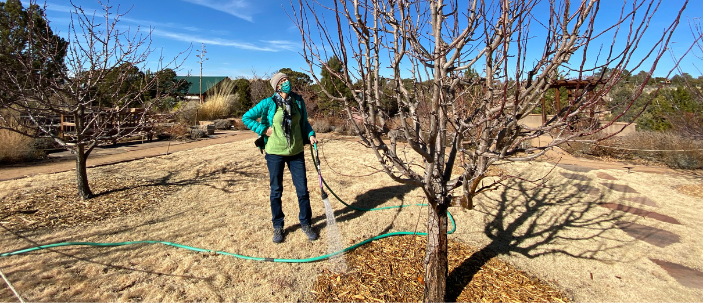
Winter Watering in the High and Dry Steppe
The Santa Fe Area and Surrounds
By Linda Churchill, Head Gardener
If you’re gardening in or around the Santa Fe area, you probably should be watering your garden this winter — and most winters, if your garden includes anything other than the most regionally adapted and established native plants. How often and how much depend on a number of things: how much precipitation we receive over the winter, how thirsty your plants are in general, the type of soil you have, how recently your plants were planted and even the various microclimates of your garden.
In the winter, you’re not watering to replace water the plants have lost through the process of growing (evapotranspiration). You are watering primarily to keep the plant roots from drying out, so that when the warmer temperatures and longer days of spring arrive the roots are full and ready to start their underground work of supplying water and nutrients from the soil. If your soil is more clay, or more thickly mulched, or in shade, you will not need to water as much or as frequently.
As a general rule of thumb, we need to water more in early winter when roots are still active and the soil is still warm, and in early spring, when roots may be starting to respond to the seasonal changes of spring, even if the tops of the plants still show little sign of growth. This may mean two or three times a month in November and March, more frequently if the soil is sandy or the garden is in strong sun. In deepest winter you may not need to water more than once a month, or not at all if the soil is frozen. If you overwater frozen soil, you may end up with soil that’s waterlogged when it thaws out, creating an anaerobic condition that is not good for soil or plants.
At the Botanical Garden, we generally water all the gardens regularly through November and into early December. By late December, many areas are frozen, especially those in more shade and those facing north, and do not thaw out until February in most winters. The Ojos Y Manos garden across the red bridge is all on a south-facing slope so tends to need water sooner in winter than the Orchard Gardens.
By March, even though we can sometimes still get quite a bit of snow, roots are stirring and we are usually past our coldest season. We try to water at least every other week in March. But as always, check your soil by feel if possible. We mulch our fruit trees quite heavily, and we find that under 5 inches of mulch it’s often still moist or frozen. But where areas are in sun, with less mulch, we are definitely watering to supplement the snow or rain. It very rarely snows enough to create moist spring soil.
Be careful to watch the soil around more recently planted plants, as their roots are usually not far enough into the surrounding soil to protect them from drying soils and winter winds. They may need a little more water than other, more established plants.
Established natives probably can get by with far less frequent winter water, but to do well in a garden setting, as opposed to a native or naturalistic setting, they also will need to be watered at least a few times in winter. Even a garden of only native plants will need regular water until well established, which can take several years at 7,000 feet.


